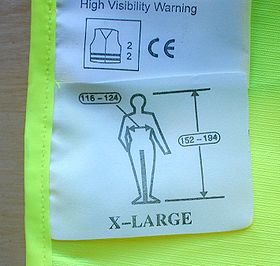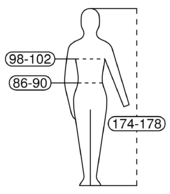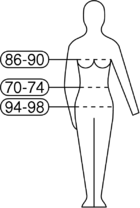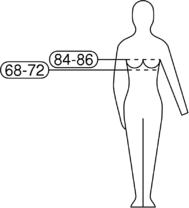- EN 13402
-
 Clothes-size label with EN 13402-1 pictogram and body dimensions in centimetres (found on a high-visibility jacket sold in the United Kingdom).
Clothes-size label with EN 13402-1 pictogram and body dimensions in centimetres (found on a high-visibility jacket sold in the United Kingdom).
EN 13402 is a European standard for labelling clothes sizes. It is based on body dimensions, measured in centimetres. It replaces many older national dress-size systems in popular use before the year 2007. Acceptance of this form of standardization varies from country to country. For example, the Spanish Ministry of Health and Consumer Affairs has commissioned a study[1] to categorise female body types with a view to harmonising Spanish clothing sizes with EN-13402. Few other countries are known to have followed suit.
Contents
Background
There are three approaches for size-labelling of clothes:
- body dimensions
- The product label states for which range of body dimensions the product was designed. (Example: bike helmet labelled "head girth: 56–60 cm", shoe labelled "foot length: 28 cm")
- product dimensions
- The label states characteristic measures of the product. (Example: jeans labelled with their inner-leg length in centimetres or inches: i.e., not the inner leg length of the intended wearer)
- ad-hoc size
- The label provides a size number or code with no obvious relationship to any measurement. (Example: Size 12, XL)
Traditionally, clothes have been labelled using many different ad-hoc size systems. This approach has led to a number of problems:
- Country-specific or even vendor-specific labels create additional costs.
- Ad-hoc sizes have changed with time, often due to "vanity labelling", an inflation in body dimensions associated with a size, to avoid confronting aging customers with uncomfortable anthropometric truths.
- Mail-order purchasing requires accurate methods for predicting the best-fitting size.
- For many types of garments, size cannot be described adequately by just a single number, because two independent body dimensions have to match for a good fit, sometimes even three. (This is a problem in sizing jeans.)
- Scalar ad-hoc sizes based on 1950s anthropometric studies are no longer adequate, as changes in nutrition and life styles have shifted the distribution of body dimensions.
Therefore, the European standards committee CEN/TC 248/WG 10 started in 1996 the process of designing a new modern system of labelling clothes sizes, resulting in the standard EN 13402 "Size designation of clothes".
It is based on
- body-dimensions
- the metric system (SI)
- data from new anthropometric studies of the European population performed in the late 1990s
- similar existing international standards (ISO 3635, etc.)
EN 13402-1: Terms, definitions and body measurement procedure
The first part of the standard defines the list of body dimensions to be used for designating clothes sizes, together with an anatomical explanation and measurement guidelines. All body dimensions are measured, preferably without or as few as possible clothes, in centimetres, except for the body mass.
The standard also defines a pictogram that can be used in language-neutral labels to indicate one or several of the following body dimensions.
- head girth
- maximum horizontal girth (circumference) of the head measured above the ears
- neck girth
- girth of the neck measured with the tape measure passed 2 cm below the Adam's apple and at the level of the 7th cervical vertebra
- chest girth
- maximum horizontal girth measured during normal breathing with the subject standing erect and the tape-measure passed over the shoulder blades (scapulae), under the armpits (axillae), and across the chest
- bust girth
- maximum horizontal girth measured during normal breathing with the subject standing erect and the tape-measure passed horizontally, under the armpits (axillae), and across the bust prominence (preferably measured with moderate tension over a brassiere that shall not deform the breast in an unnatural way and shall not displace its volume)
- underbust girth
- horizontal girth of the body measured just below the breasts
- waist girth
- girth of the natural waistline between the top of the hip bones (iliac crests) and the lower ribs, measured with the subject breathing normally and standing erect with the abdomen relaxed
- hip girth
- horizontal girth measured round the buttocks at the level of maximum circumference
- height
- vertical distance between the crown of the head and the soles of the feet, measured with the subject standing erect without shoes and with the feet together (for infants not yet able to stand upright: length of the body measured in a straight line from the crown of the head to the soles of the feet)
- inside leg length
- distance between the crotch and the soles of the feet, measured in a straight vertical line with the subject erect, feet slightly apart, and the weight of the body equally distributed on both legs
- arm length
- distance, measured using the tape-measure, from the armscye/shoulder line intersection (acromion), over the elbow, to the far end of the prominent wrist bone (ulna), with the subject's right fist clenched and placed on the hip, and with the arm bent at 90°
- hand girth
- maximum girth measured over the knuckles (metacarpals) of the open right hand, fingers together and thumb excluded
- foot length
- horizontal distance between perpendiculars in contact with the end of the most prominent toe and the most prominent part of the heel, measured with the subject standing barefoot and the weight of the body equally distributed on both feet
- body mass
- measured with a suitable balance in kilograms
EN 13402-2: Primary and secondary dimensions
The second part of the standard defines for each type of garment one "primary dimension". This is the body measure according to which the product must be labelled. Where men’s garments use the chest girth, women’s clothes are designed for a certain bust girth.
For some types of garment, a single measure may not be sufficient to select the right product. In these cases, one or two "secondary dimensions" can be added to the label.
The following table shows the primary and secondary dimensions listed in the standard, leaving out the redundant words girth, length and size for better overview. Secondary dimensions are shown in parentheses.
Garment Men Women Boys Girls Jackets chest, height, waist bust, height, hip height, chest height, bust Suits chest, waist, height, inside leg bust, height, hip height, chest height, bust Overcoats chest, height bust, height height, chest height, bust Trousers/shorts waist, height, inside leg waist, height, hip, inside leg height, waist height, waist Skirts — waist, height, hip — height, waist Dresses — bust, height, hip, waist — height, bust Knits: cardigans, sweaters, T-shirts chest, height bust, height height, chest height, bust Shirts (m), Blouses (f) neck, height, arm bust, height height, neck height, bust Underpants waist, height waist, height, hip height, waist height, waist Vest chest, height bust, height height, chest height, bust Pyjamas, Ladies' nightdresses chest, height, waist bust, height, waist, hip height, chest height, bust Swim-suits/wear and bodies waist, height, chest bust, height, hip, underbust height, chest, waist height, underbust, bust Bras — underbust, bust, cup — underbust, bust, cup Corsetry/upper and full body — underbust, bust, height, hip, waist — — Corsetry/lower body — waist, hip, height — — Pantyhose — height, waist, weight — height Stockings — foot Socks foot Gloves hand Headwear head EN 13402–3: Measurements and intervals
The third part of the standard defines preferred numbers of primary and secondary body dimensions.
The product should not be labelled with the average body dimension for which the garment was designed (i.e., not "height: 176 cm."). Instead, the label should show the range of body dimensions from half the step size below to half the step size above the design size (e.g., "height: 172–180 cm.").
For heights, for example, the standard recommends generally to use the following design dimensions, with a step size of 8 cm:
Height … 160 168 176 184 192 200 … Range … 156–164 164–172 172–180 180–188 188–196 196–204 … For trousers, the recommended step size for height is 4 cm:
Height … 156 160 164 168 172 176 180 184 188 192 196 200 … Range … 154–158 158–162 162–166 166–170 170–174 174–178 178–182 182–186 186–190 190–194 194–198 198–202 … The standard defines similar tables for other dimensions and garments, only some of which are shown here.
Men
The standard sizes and ranges for chest and waist girth are defined in steps of 4 cm:
Men’s standard sizes for drop = −12 cm Chest girth 84 88 92 96 100 104 108 112 116 120 126 132 138 144 Range 82–86 86–90 90–94 94–98 98–102 102–106 106–110 110–114 114–118 118–123 123–129 129–135 135–141 141–147 Waist girth 72 76 80 84 88 92 96 100 104 108 114 120 126 132 Range 70–74 74–78 78–82 82–86 86–90 90–94 94–98 98–102 102–106 106–111 111–117 117–123 123–129 129–135 - drop = waist girth − chest girth.
Example: While manufacturers will typically design clothes for chest girth = 100 cm such that it fits waist girth = 88 cm, they may also want to combine that chest girth with neighbouring waist girth step sizes 84 cm or 92 cm, to cover these drop types (−16 cm and −8 cm) as well.
The standard also suggests that neck girth can be associated with chest girth:
Association of neck and chest girth Neck girth 37 38 39 40 41 42 43 44 45 46.5 48 49.5 51 Range 36.5–37.5 37.5–38.5 38.5–39.5 39.5–40.5 40.5–41.5 41.5–42.5 42.5–43.5 43.5–44.5 44.5–45.8 45.8–47.3 47.3–48.8 48.8–50.3 50.3–51.1 Chest girth 88 92 96 100 104 108 112 116 120 126 132 138 144 The standard further suggests that arm length can be associated with height:
Association of arm length and body height Height 156 160 164 168 172 176 180 184 188 192 196 200 Arm length 60 61 62 63 64 65 66 67 68 69 70 71 Range 59–60 60–61 61–62 62–63 63–64 64–65 65–66 66–67 67–68 68–69 69–70 70–71 Women
Dress sizes
The standard sizes and ranges for bust, waist and hip girth are mostly based on a step of 4 cm, for larger sizes 5 cm:
Bust girth 76 80 84 88 92 96 100 104 110 116 122 128 134 140 146 152 Range 74–78 78–82 82–86 86–90 90–94 94–98 98–102 102–107 107–113 113–119 119–125 125–131 131–137 137–143 143–149 149–155 Waist girth 60 64 68 72 76 80 84 88 94 100 106 112 118 124 130 136 Range 58–62 62–66 66–70 70–74 74–78 78–82 82–86 86–91 91–97 97–103 103–109 109–115 115–121 121–127 127–133 133–139 Hip girth 84 88 92 96 100 104 108 112 117 122 127 132 137 142 147 152 Range 82–86 86–90 90–94 94–98 98–102 102–106 106–110 110–115 115–120 120–125 125–130 130–135 135–140 140–145 145–150 150–155 Bra sizes
The European standard EN 13402 also defines bra sizes based on the "bust girth" and the "underbust girth". Bras are labeled with the under bust girth (rounded to the nearest multiple of 5 cm), followed by a letter code that indicates the "cup size" defined below, according to this table defined by the standard.
The standard sizes for brassiere are based on a step of 5 cm:
Underbust girth 60 65 70 75 80 85 90 95 100 105 110 115 120 125 Range 58–62 63–67 68–72 73–77 78–82 83–88 88–92 93–98 98–102 103–108 108–112 113–118 118–122 123–128 The secondary dimension cup size can be expressed in terms of the difference
- cup size = bust girth − underbust girth
and can be labelled compactly using a letter code appended to the underbust girth:
Code AA A B C D E F G H J K Cup size range 10–12 12–14 14–16 16–18 18–20 20–22 22–24 24–26 26–28 28–30 30–32 Example 1: Bra size 70B is suitable for women with underbust girth 68–72 cm and bust girth from 82–84 cm to 86–88 cm.
Example 2: A woman with an underbust girth of 89 cm and a bust girth of 108 cm has cup size 19 cm (= 108 cm – 89 cm) or "D". Her underbust girth rounded to the nearest multiple of 5 cm is 90 cm. Therefore, her bra size according to the standard is 90D.
Letter codes
For clothes where a larger step size is sufficient, the standard also defines a letter code. This code represents the bust girth for women and the chest girth for men. The standard does not define such a code for children. Each range combines two adjacent size steps. The ranges could be extended below XXS or above 3XL if necessary.
Meaning Code Chest girth (men) Bust girth (women) extra extra small XXS 70–78 66–74 extra small XS 78–86 74–82 small S 86–94 82–90 medium M 94–102 90–98 large L 102–110 98–107 extra large XL 110–118 107–119 extra extra large XXL 118–129 119–131 extra extra extra large 3XL 129–141 131–143 4XL 141–154 143–155 5XL 154–166 155–167 EN 13402-4: Coding system
The fourth part of the standard is still under review. It will define a compact coding system for clothes sizes. This was originally intended primarily for industry use in databases and as a part of stock-keeping identifiers and catalogue ordering numbers, but later users have also expressed a desire to use compact codes for customer communication. Writing out all the centimetre figures of all the primary and secondary measures from EN 13402-2 can – in some cases – require up to 12 digits. The full list of centimetre figures on the pictogram contains a lot of redundancy and the same information can be squeezed into fewer characters with lookup tables. EN 13402-4 will define such tables.
An earlier draft of this part of the standard attempted to list all in-use combinations of EN 13402-3 measures and assigned a short 2- or 3-digit code to each. Some of the industry representatives involved in the standardization process considered this approach too restrictive. Others argued that the primary dimension in centimetres should be a prominent part of the code. Therefore this proposal, originally expected to be adopted in 2005, was rejected.
Since then, several new proposals have been presented to the CEN working group. One of these, tabled by the European Association of National Organisations of Textile Traders (AEDT), proposes a 5-character alphanumeric code, consisting of the 3-digit centimetre figure of the primary body dimension, followed by one or two letters that code a secondary dimension, somewhat like the system already defined for bra sizes.[2] For example, an item designed for 100 cm bust girth, 104 cm hip girth and 176 cm height could bear the compact size code "100BG". This proposal was agreed upon in 2006, but later disregarded.[3] A paper by Bogusławska-Bączek published in 2010 showed that there were still significant difficulties in identifying clothing sizes.[4]
References
- ^ The anthropometric study of the female population has revealed the existence of three generalised body types, which should serve as a more accurate basis for sizing
- ^ CEN/TC 248/WG 10 N 285
- ^ AEDT: Study on labelling of textile products
- ^ Bogusławska-Bączek, Monika (September 2010). "Analysis of the contemporary problem of garment sizing sizes". 7th International Conference - TEXSCI 2010. http://wjoe.hebeu.edu.cn/sup.2010/Clothing%20Science%20and%20Technology/7_p_baczek.pdf. Retrieved 29 October 2011.
Related links
Construction Eurocodes: EN 1990 · EN 1991 · EN 1992 · EN 1993 · EN 1994 · EN 1995 · EN 1996 · EN 1997 · EN 1998 · EN 1999Safety Other EN 13402List External links
- All change for clothes sizes – press release by the British Standards Institution (11 March 2002)
- Dress size harmonization – press release by the British Standards Institution (24 October 2003)
- John Scrimshaw: One size really might fit all. Fashion Business International, March 2004.
- Karryn Miller: Sizing a headache for globalising apparel industry. just-style, 27 July 2010.
- BodyDim: program for calculating out EN13402 values
Categories:- Sizes in clothing
- EN standards
- Metrication
- Fashion design
Wikimedia Foundation. 2010.



